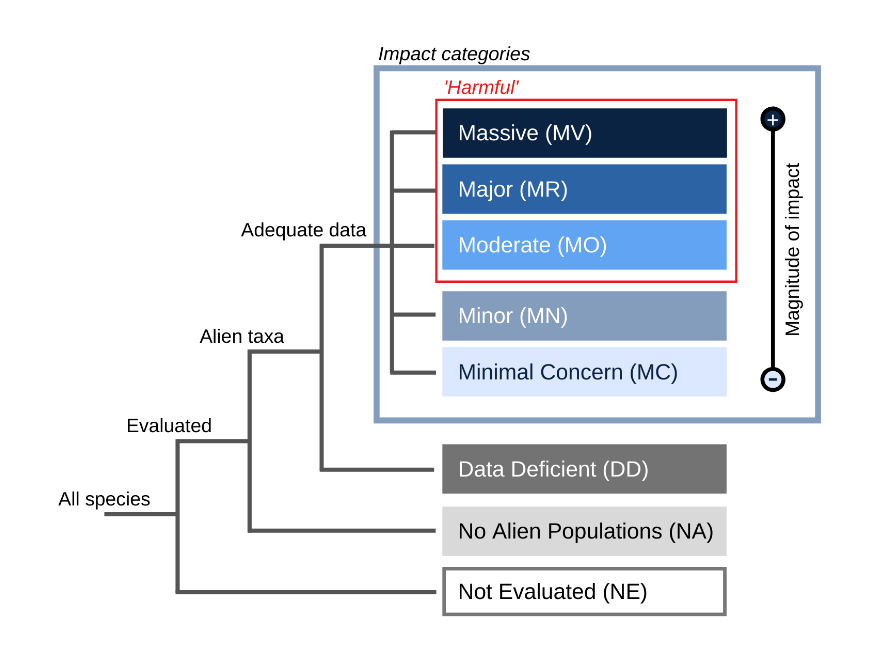IUCN Standard to support global action on invasive alien species
IUCN today launched a global standard for classifying the severity and type of impacts caused by alien species, known as the Environmental Impact Classification for Alien Taxa (EICAT). This tool will alert scientists, conservation practitioners and policy makers to the potential consequences of invasive alien species, guiding the development of prevention and mitigation measures.

Introduced to the UK, Ireland, Italy and South Africa, the Gray Squirrel (Sciurus carolinensis) damages trees, and in Europe causes the extinction of Red Squirrel (Sciurus vulgaris) populations through competition and disease.
Photo: Tim Blackburn
“Addressing the impacts of invasive alien species is vital to tackling escalating biodiversity loss and the extinction crisis, and their significant effects on economies, livelihoods and wellbeing,” said Dr Jane Smart, Global Director of the IUCN Biodiversity Conservation Group. “This new tool will provide key information for national, regional and global institutions to make decisions on where to target their resources, supporting the scaling up of conservation efforts worldwide.”
The growing movement of goods and people around the globe is introducing animals, fungi, plants and pathogens to areas outside their natural range at an ever-increasing rate. These alien species can become invasive, negatively impacting their new environment, threatening biodiversity and ecosystems. According to the IUCN Red List of Threatened SpeciesTM and the 2019 IPBES Global Assessment Report on Biodiversity and Ecosystem Services, invasive alien species are one of the main direct drivers of biodiversity loss and species extinctions. Furthermore, they are one of the most serious and rapidly growing threats to food, health and livelihood security.
However, resources to prevent introductions and manage established invasive alien species are scarce. It is therefore critical to prioritise responding to those invasive alien species that would potentially lead to the most harmful impacts.
EICAT aims to support the identification of priority invasive alien species to address. It is a simple and objective standard that classifies alien species into impact categories based on evidence of the harm they cause. The five categories, in order of increasing impact, are Minimal Concern, Minor, Moderate, Major and Massive. Species in the latter three categories are considered ‘harmful’. The scheme is applicable at national, regional and global levels; all EICAT assessments undertaken at the global level will be available through IUCN’s Global Invasive Species Database.
 Environmental Impact Classification for Alien Taxa Categories
Photo: IUCN
Environmental Impact Classification for Alien Taxa Categories
Photo: IUCN
“Standardised information on invasive alien species is essential to understanding and managing the challenges they pose,” said Dr Piero Genovesi, Chair of the IUCN SSC Invasive Species Specialist Group, which developed EICAT. “EICAT is a tool to categorise and compare the various impacts of invasive alien species around the world, informing policies and action. I thank the many invasive species experts that contributed to developing a method that is scientifically rigorous, transparent and applicable to all taxonomic groups and environments.”
EICAT will support actions towards the United Nations Sustainable Development Goals’ Target 15.8, which calls for measures to prevent the introduction and reduce the impact of invasive alien species. With no standardised process already in place, parties to the Convention on Biological Diversity invited the IUCN SSC Invasive Species Specialist Group to develop a system for classifying invasive alien species based on the severity and type of their impacts, adopting a similar approach to the IUCN Red List of Threatened SpeciesTM. Following publication of the initial EICAT scheme in scientific literature, an IUCN-wide consultation process took place, mandated by an IUCN Resolution. The resulting EICAT Categories and Criteria document has been officially adopted as an IUCN standard.
EICAT can be accessed here.



